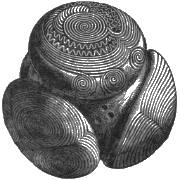Canmore Site 53908: KIRK PARK, MUSSELBURGH - INVERESK (EAST LOTHIAN) - CINERARY URN(S) (BRONZE AGE), PYGMY CUP(S) (BRONZE AGE)
Description
| Site Name | KIRK PARK, MUSSELBURGH |
|---|---|
| Other Name(s) | KIRKPARK |
| Site Number | NT37SW 7 |
| Broad Class | CONTAINER, RELIGION OR RITUAL |
| Site Type(s) | CINERARY URN(S) (BRONZE AGE), PYGMY CUP(S) (BRONZE AGE) |
| NGR | NT 3416 7228 |
| NGR accuracy | NGR given to the nearest 10m |
| Local Authority | EAST LOTHIAN |
| Parish | INVERESK (EAST LOTHIAN) |
| Record created | 1988-05-03 |
| Last updated | 2000-04-12 |
Archaeology Notes
NT37SW 7 3416 7228
See also NT37SW 6.
(NT 3416 7228) Cinerary Urns found AD 1893 (NAT)
OS 25" map (1967)
A Bronze Age burial ground was revealed by excavations in a sand pit at Kirkpark. Including those which did not survive, a total of at least 19 cinerary urns and accessory vessels were found. The first cinerary urn (see fig 1 in Anderson 1894) was found in 1887, and the others, with the exception of the last, were found in 1893 when sand was again being removed from the same location. No details are given of the first find, but in April 1893, a second urn was found. It fell to pieces on exposure to the air. The next urn (fig 2) was excavated by Lowe. It was found, containing a few calcined bones, inverted over a layer of black material (which was present in every case where the urn was found inverted - evidently due to the burnt material thrown into the grave along with the bones.
Urns 4 and 5, both broken, which were about 12" high, were apparently protected by two stone slabs, which had fallen and destroyed the urns. Urn 4 was scattered beyond recovery, but no 5 was recovered (fig 3).
In the next grave were two accessory vessels (figs 4 and 5), both full of bones and sand. That shown on fig 5 was found upright, in the midst of the black material. A day or two later, a grave containing 4 urns was found (see figs 6 - 9). The cinerary urn shown in fig 6 contained an accessory vessel (fig 7). The other two contained a few bones. One lay under, and the other was 1' S of, the cinerary urn.
The 12th urn found (fig 10) was another accessory vessel, standing upright and empty. The next urn (fig 11) was found upright in a grave which contained no black material. It contained bones and a flint chip, not unlike a flint arrowhead in shape.
For some weeks after these discoveries, no more urns were found, though many graves were noted. Eight were dug out; the indications were the same as in previous cases: dark brown sand and a layer of discoloured matter containing bones.
Urn 14 was found only about 1' from where the sand had been removed in 1887. It was a large cinerary urn, which came to pieces on removal, so it could not be reconstructed. Not far away were two graves, within 2' of each other. Each contained a cinerary urn (figs 12 and 13). Both urns, inverted over bones, contained bones which had been stained green by the oxidation of some bronze implement which had also been placed in each of the urns. Urn 17, another large cinerary run, was found standing upright in the midst of large stones. It contained only soil. All the recoverable urns were given to the NMAS as Treasure Trove (Acc Nos: EA 143-151 and EC 29-33).
Turner notes that at an unspecified date after the finds described above had been made, Prof A Thompson exposed in the same sand pit a cinerary urn which had been protected by stones placed around it, but not forming a built cist. It contained calcined bones and bits of charcoal. This urn was donated to the NMAS in 1963-4. (See also NT37SW 6)
W Turner 1917; E D Dennison 1917; J M Coles 1966; Proc Soc Antiq Scot 1966
Enquiries at Musselburgh Town Council office identified the area in which the OS siting symbol is located as Kirkpark. The site, on the gently rising N slope of the hill, is now occupied by factory premises. Visited by OS (JLD) 23 December 1953
Confirmed. See also NT37SW 6 Cists
Visited by OS (SFS) 15 August 1975
Identifiers and Links to Other Records
This record has no links! Would you like to help?
| Identifier / External Link | Linked Record | Status | Comment |
|---|---|---|---|
| Canmore Site Number (legacy): NT37SW 7 | No linked record |
This area is visible only to logged in users.
